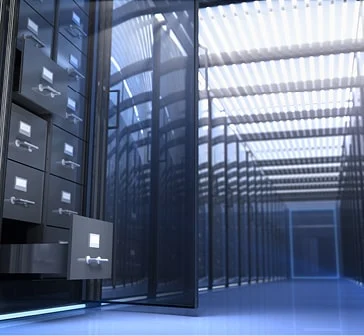
The collection and preservation of data has been the true building block of human civilization. From pictographs and ancient cave paintings to the trove of scrolls in the fabled Library of Alexandria through to the modern World Wide Web, the need to store, preserve, and pass on knowledge has remained ever-present. In many ways, these historical repositories were early versions of data centers, designed to safeguard and distribute information. Today, the demand for data storage is more pressing than ever, and in 2025, more data centers will be under construction than at any other time in history.
The mere expansion of data centers is not enough. Existing infrastructures must be modernized to handle the exponential growth in data storage demand fueled by Artificial Intelligence (AI) and Machine Learning (ML). Future-proofing these facilities is not just about expanding capacity, but about ensuring that data remains accessible, usable, and protected throughout its lifecycle.
The AI/ML Data Explosion
AI and ML have fundamentally changed how data is used and stored. In 2023 alone, global data generation reached 120 zettabytes, and by 2025, that number is expected to surge past 181 zettabytes—a 150% increase driven primarily by AI/ML demands.
This explosion in data is due to AI/ML’s unique ability to re-assess and refine information datasets and raw data indefinitely. Previously, data functioned like milk on a shelf—used once for a specific purpose and discarded when no longer needed for its initial processing or tossed after whatever the organizational directive of the day happened to be. Now, organizations are finding generational value from data even after its initial ‘use by date’ as they continue to train and enhance AI/ML models.
However, retaining data without an organizational data governance plan—covering compliance, resilience, and recovery—can lead to chaos. Organizations can keep all their data and have goals to implement any specific tools, applications, or initiatives they want, but if they aren’t diligent about data governance requirements, it could lead to an organizational, or even compliance morass.
With the new and fast-evolving AI/ML tool pipelines, there are many storage solutions to consider to achieve the most performance, efficiency, and economic leverage, which can be overwhelming. That’s why organizations must first assess their historical data strategies, analyze how AI is reshaping their needs, and identify where bottlenecks exist or may arise, so they can implement the right infrastructure to support their unique needs now and be ready for future needs.
Overcoming Legacy Storage Challenges
Modernizing existing data centers is essential as traditional, static infrastructures increasingly give way to flexible architectures—but this transformation presents significant challenges. Historically, data centers have supported a monolithic model, pairing dedicated servers with isolated storage systems optimized for structured, siloed workloads. They may have been served from virtual machine servers, or ‘big iron’ servers to power critical enterprise or organizational applications. Either way, these legacy systems were built around fixed hardware configurations and rigid capacity limits, meaning storage expansion often required costly operational downtime and service disruption.
Further complicating the issue, storage for applications or enterprise services was traditionally composed of multiple discrete storage arrays. If an organization needed to expand storage capacity, it had to halt operations on one of these critical servers before physically adding new storage hardware—an outdated approach incompatible with modern data demands.
Today’s AI/ML-driven workflows require a fundamentally different approach: scalable, integrated systems that dynamically adapt to evolving data requirements without interrupting operations. These workloads introduce new bottlenecks in data workflows, notably with the rise of Graphics Processing Units (GPUs) alongside Central Processing Units (CPUs). AI-driven applications demand high-performance computing and rapid, flexible data access—something traditional storage architectures struggle to deliver.
However, organizations do not necessarily have to build entirely new infrastructures from scratch. Instead, they can address storage challenges by assessing existing workflows and identifying specific performance bottlenecks. This means asking targeted questions like “Is a user or application waiting too long for data access?” or “Could performance tuning improve efficiency at certain stages of data retrieval or processing?” By carefully evaluating workflow demands, organizations can strategically optimize their existing storage infrastructure without unnecessary overhauls.
Ultimately, data centers and storage solutions must evolve into strategic resources capable of adapting dynamically to support an organization’s mission while simultaneously achieving efficiency and cost objectives.
The “Flight Simulator” Mindset for Data Storage
To effectively future-proof data centers, organizations must adopt a “flight simulator” mindset—thinking multiple steps ahead, your response to a number of ‘what if’ scenarios, prioritizing agility, and planning for scalability. This approach requires continuously evaluating workflows by determining several factors, including how fast data is being processed, how many users are accessing storage simultaneously, and what happens if data accumulation rates double, triple, or quadruple – and developing a ‘workflow action plan’ in advance for each.
By simulating these scenarios in advance and thinking through how you’d respond, organizations can develop strategies to scale their storage needs— whether shifting to an object storage data ‘backplane’ for your apps. This could be on-premises and within your private data centers, public cloud infrastructure, on-premises system scaling, or a hybrid model of any of the above. This mindset also means preparing for external disruptions, such as tariffs, supply chain disruptions, and natural disasters. Organizations need storage architectures that are flexible, scalable, and resilient to unforeseen challenges.
One effective solution is object storage, which allows data to grow dynamically in any direction without requiring system shutdowns. Object storage also takes over many responsibilities traditionally assigned to legacy storage systems, offering a streamlined approach to data management.
Ultimately, flexible and scalable storage is an ongoing requirement, and legacy solutions simply are not built to keep up with modern demands. Organizations must ensure that their storage infrastructures can expand seamlessly without costly downtime or operational inefficiencies.
The Future of Data Centers
Data centers have become the backbone of modern technology, storing and processing the vast quantities of information that drive AI and ML innovations. However, their importance also comes with an urgent need for modernization and efficiency planning.
Legacy systems, built for a different era of computing, struggle to keep pace with today’s data demands. Organizations must proactively analyze their current storage infrastructures, anticipate future bottlenecks, fine-tune their current workflow to eliminate these bottlenecks, and implement scalable solutions that grow with their needs. Modernizing data centers is not a one-time project—it requires ongoing strategy, execution, and reassessment. Organizations must be prepared to continuously refine their data management plans, ensuring they remain adaptable to ever-evolving AI/ML advancements.
By embracing a forward-thinking mindset and preparing for the unexpected, organizations can ensure that their data storage infrastructure remain resilient, efficient, and ready for the AI-driven future.



